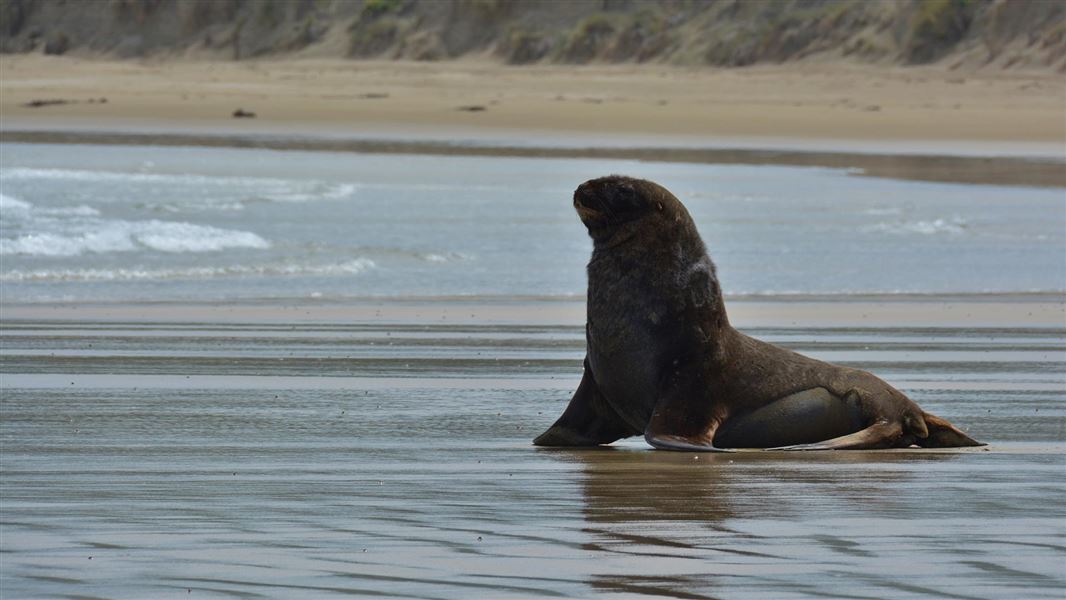If you see a sea lion
If you are in New Zealand and spot a sea lion, you're seeing one of the rarest sea lions in the world. They're Nationally Vulnerable and protected.
It's an offence under the Marine Mammals Protection Act 1978 to disturb, harass, harm, injure or kill a New Zealand sea lion. A dog owner whose dog attacks a seal could face prosecution.
How to behave
- Minimise disturbance. Stay at least 10 m from them, 20 m if you're with your dog (always on lead).
- Sea lions are confident with humans. Don't run away from them. Back off slowly if you're too close, and avoid direct eye contact. They are unlikely to pursue you.
- Unlike fur seals, you can walk between a sea lion and the water, unless they're heading to the sea.
- Keep an eye out, as a female's fur colour is similar to sand. They might be hidden between dunes.
- Move slowly away if you're in the water.
How to identify a New Zealand sea lion
If you need help identifying species, download the Marine mammal sighting form (PDF, 416K or Word, 4,300K). Use the images and descriptions to find out whether or not you're looking at a New Zealand sea lion.
New Zealand fur seals can be distinguished from sea lions by their pointy nose and smaller size. In New Zealand, fur seals also tend to be found on rocky shorelines, whereas sea lions prefer sandy beaches.
| New Zealand sea lion | New Zealand fur seal | |||
|---|---|---|---|---|
| Male | Female | Male | Female | |
| Nose | Blunt nose and short whiskers | Long nose and long pale lashes | ||
| Fur | One layer of velvet-like fur | Covered with two layers of fur | ||
| Colour | Brown to black with well-developed manes reaching to shoulders | Lighter colour, mostly creamy grey with darker colour around flippers | Dark grey-brown on back, and lighter below | |
| Length | Length 2.4–3.5 m | Length 1.6–2.0 m | Max length 2.5 m | Max length 1.5 m |
| Weight | Weight 250–400 kg | Weight 100–160 kg | Weight 90–150 kg | Weight 30–50 kg |

Male sea lion
Image: Laura Boren | DOC

Male fur seal
Image: Katherine Clements | DOC

Female sea lion
Image: Hannah Hendriks | DOC

Female fur seal
Image: Katherine Clements | DOC
Report sightings of sea lions
We are particularly interested in sightings of sea lions which are rarely seen in New Zealand.
You can report sightings of sea lions to our conservation hotline 0800 DOC HOT (0800 362 468). You can also report a sighting online.
Reports of sightings are always valuable and help increase our knowledge of sea lion distribution and movements around New Zealand.
If you need help identifying species, download the marine mammal sighting form (PDF, 416K) (Word, 4,300K). You can use the images and descriptions to find out which species of sea lion you observed.
Record the details
Include as much information as possible with your sighting:
- the date, time and location (GPS coordinates if possible)
- male (black/dark and big) or female (smaller, sand beach colour)
- the number of seals and estimated sizes
- take photographs or video if possible.
Call the DOC conservation emergency hotline 0800 DOC HOT (0800 362 468) if you see a sea lion that is:
- severely injured
- entangled in marine debris
- being harassed by people or dogs.
